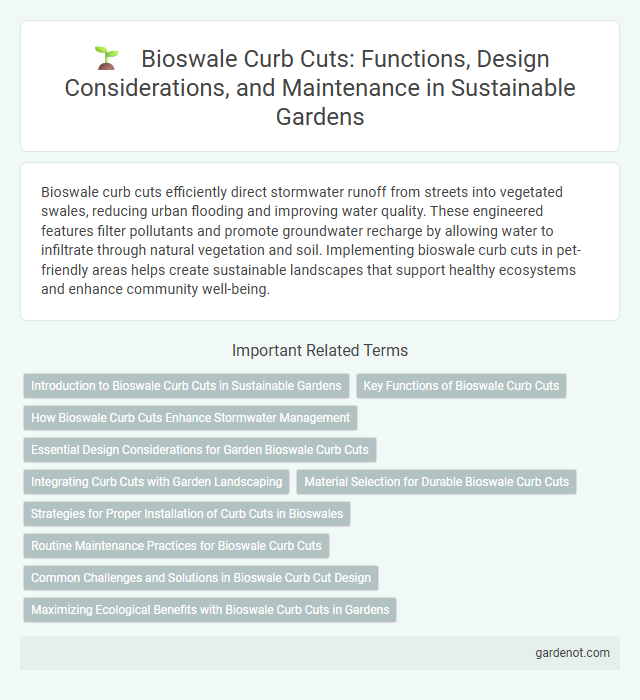Bioswale curb cuts efficiently direct stormwater runoff from streets into vegetated swales, reducing urban flooding and improving water quality. These engineered features filter pollutants and promote groundwater recharge by allowing water to infiltrate through natural vegetation and soil. Implementing bioswale curb cuts in pet-friendly areas helps create sustainable landscapes that support healthy ecosystems and enhance community well-being.
Introduction to Bioswale Curb Cuts in Sustainable Gardens
Bioswale curb cuts are engineered openings in curbs that direct stormwater runoff into bioswales, enhancing water infiltration and reducing urban flooding. These features incorporate native vegetation and porous soil media to filter pollutants and improve groundwater recharge. Integrating bioswale curb cuts in sustainable gardens promotes eco-friendly water management and supports urban biodiversity.
Key Functions of Bioswale Curb Cuts
Bioswale curb cuts are designed to facilitate stormwater runoff infiltration, reducing surface water accumulation and enhancing groundwater recharge. They direct polluted urban runoff through vegetated swales that filter sediments, nutrients, and contaminants before water reaches storm drains. These curb cuts improve urban water management by mitigating flooding, promoting natural filtration, and supporting sustainable drainage systems.
How Bioswale Curb Cuts Enhance Stormwater Management
Bioswale curb cuts significantly improve stormwater management by directing runoff into permeable, vegetated channels that promote infiltration and reduce surface water overflow. These infrastructure elements filter pollutants, sediment, and debris from stormwater before it reaches local water bodies, enhancing water quality and mitigating urban flooding. Integrating bioswale curb cuts into urban planning supports sustainable drainage systems and helps control peak stormwater flow rates during heavy rainfall events.
Essential Design Considerations for Garden Bioswale Curb Cuts
Bioswale curb cuts require precise grading to ensure effective stormwater flow into the garden bioswale while preventing overflow onto adjacent surfaces. Incorporating a permeable material and proper slope design enhances infiltration, reduces runoff velocity, and minimizes erosion. Strategically placing curb cuts in low points along streets optimizes water capture and supports sustainable urban drainage systems.
Integrating Curb Cuts with Garden Landscaping
Bioswale curb cuts enhance stormwater management by seamlessly integrating with garden landscaping, allowing runoff to flow directly into vegetated swales for natural filtration. These curb cuts are designed to optimize water infiltration and reduce urban flooding while supporting native plant growth. Incorporating bioswale curb cuts boosts both environmental sustainability and aesthetic appeal in urban green infrastructure.
Material Selection for Durable Bioswale Curb Cuts
Selecting durable materials for bioswale curb cuts is essential to ensure long-lasting performance and effective stormwater management. Common materials include reinforced concrete, permeable pavers, and corrosion-resistant metals, each offering strength and resistance to erosion while maintaining water permeability. Proper material choice reduces maintenance costs and supports sustainable urban drainage systems by enhancing filtration and minimizing runoff.
Strategies for Proper Installation of Curb Cuts in Bioswales
Strategies for proper installation of curb cuts in bioswales include ensuring precise grading to direct stormwater flow efficiently into the bioswale while preventing erosion and sediment buildup. Using durable, permeable materials for the curb cut enhances water infiltration and supports the bioswale's filtration functions. Regular maintenance protocols, such as debris removal and structural inspections, are essential to sustain optimal performance and prevent clogging or overflow.
Routine Maintenance Practices for Bioswale Curb Cuts
Routine maintenance practices for bioswale curb cuts include regular inspection to remove debris, sediment, and trash that can obstruct water flow and reduce infiltration efficiency. Vegetation management is essential, involving periodic trimming and replacement of plants to maintain healthy root systems and prevent overgrowth. Additionally, checking for erosion or damage to curb cut edges ensures structural integrity and optimal stormwater capture performance.
Common Challenges and Solutions in Bioswale Curb Cut Design
Bioswale curb cuts often face challenges such as soil compaction, inadequate drainage, and clogging from sediment build-up that reduce water infiltration efficiency. Implementing engineered soil media with high permeability, incorporating sediment traps, and designing appropriately sized inlets address these issues while facilitating effective stormwater management. Regular maintenance protocols and selecting native vegetation enhance long-term curb cut performance and biodiversity benefits.
Maximizing Ecological Benefits with Bioswale Curb Cuts in Gardens
Bioswale curb cuts enhance stormwater management by directing runoff into vegetated swales, promoting natural filtration and groundwater recharge. Integrating native plants within these curb cuts maximizes ecological benefits by supporting local biodiversity and improving habitat quality. Strategic placement in gardens not only reduces urban heat island effects but also improves soil health through efficient nutrient absorption.
Bioswale curb cut Infographic

 gardenot.com
gardenot.com